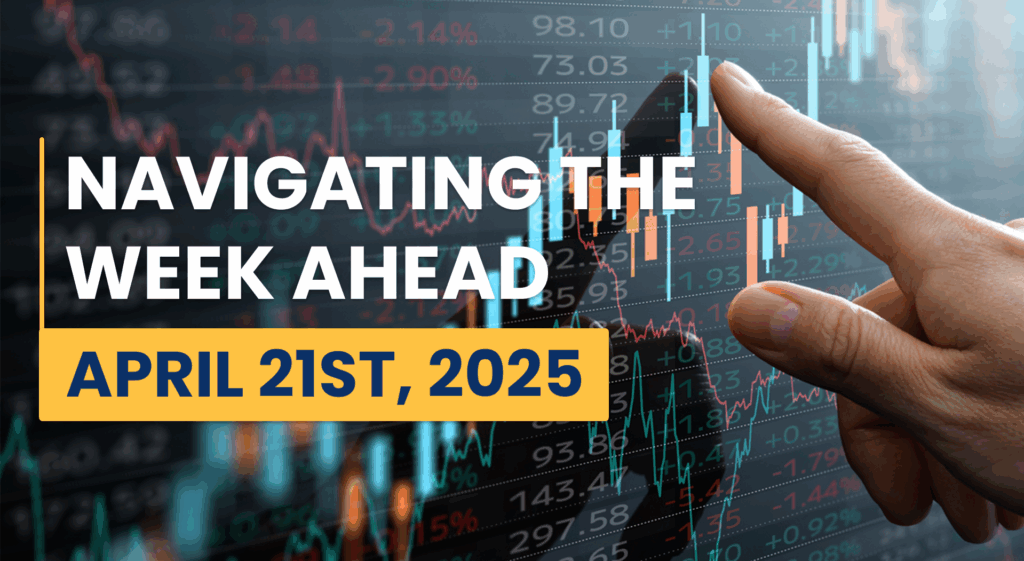Navigating the week ahead on April 21st, 2025
Article published on April 21st, 2025 5:22 PM UK Time

After a well-deserved Easter break, traders are stepping back into the fray amid one of the most chaotic stretches in recent market memory. Over the past two and a half weeks, we’ve seen a dramatic transformation in sentiment, with a clear and persistent theme: sell the U.S. Across equities, bonds, and currencies, that narrative has shaped trading flows and broken once-reliable correlations.
Where We Stand
The U.S. dollar’s downward trajectory has been relentless. Early in the new week, we saw the dollar index break below 98—a level not seen since March or April 2022. From its peak to its recent low, the dollar has lost a staggering 11% year-to-date. Bonds haven’t fared much better. T-note futures are still struggling, unable to reclaim prior highs, while equities, despite sporadic rallies, remain deeply in the red—15% down from yearly highs on the S&P 500.
What’s driving this shift? It’s more than just a change in sentiment—it’s a structural reassessment. For over a decade, markets have leaned on the U.S. as the go-to safe haven. Now, they’re reevaluating that assumption. The fallout is palpable. Correlations are disintegrating, particularly between U.S. yields and the dollar. Typically, these two move in tandem. Today, they’re diverging significantly, signaling a deep market misalignment and triggering red flags for those reliant on macro models.
Market Structure Breakdown
This dislocation isn’t just visible on daily charts. On a one-year rolling basis, the correlation between daily returns on the dollar index and 10-year yields has completely broken down. Historically tight, they now move in opposing directions—an anomaly that demands caution. When trusted intermarket relationships fracture, it’s a signal to reduce risk, step back, and reassess.
Volatility has surged across asset classes but is now starting to cool slightly. Whether it’s FX vol, bond vol, or equity measures like the VIX, the extreme fear is subsiding. That said, uncertainty is still the dominant theme.
When Macro Data Doesn’t Matter (Until It Does)
One of the most interesting aspects of the current environment is how disconnected macroeconomic data has become from market price action. Traditional catalysts—like PMIs, retail sales, inflation expectations—are no longer producing the directional moves traders typically expect. Normally, a major beat or miss in these datasets would send currencies, equities, or bonds flying. But in today’s market, the reaction is either muted or completely contrary.
This isn’t because the data isn’t relevant—it’s because the dominant narrative is bigger than the numbers. Right now, geopolitical risk and policy uncertainty are overriding traditional fundamentals. Case in point: the risk that former President Trump could attempt to remove Fed Chair Powell. Even rumors of such a move could create seismic shifts in risk sentiment, leading to a deeper dollar selloff and further pain in equity markets, regardless of whether U.S. data prints strong or weak.
Powell himself acknowledged last week that the Fed’s dual mandate—price stability and maximum employment—may soon come under pressure. Speaking about the potential effects of prolonged tariff policy, Powell noted that the inflationary impact of tariffs could conflict with the Fed’s goal of maintaining stable prices just as labor markets begin to soften. This tension, he explained, may force the Fed to make more difficult tradeoffs down the road.
This is particularly relevant because we have not yet seen the full impact of the tariffs feed into U.S. inflation data. Most of the price effects are still in the pipeline. If CPI or PCE inflation unexpectedly spikes in the coming months as tariffs push import prices higher, it could catch the market off guard—especially if it challenges current expectations for Fed rate cuts.
Similarly, the unfolding trade war and tariff escalation have altered how the market digests every headline. PMIs in Germany or the UK could come in strong, but if new levies are imposed the next day, traders fade the good data and refocus on the global slowdown narrative. In short, data still matters, but the market is distracted. It now takes a backseat to headline risk, policy threats, and geopolitical shockwaves.
What to Watch This Week
1. Central Bank Speakers and Policy Risks:
This week brings a flurry of central bank appearances, especially from the Fed and Bank of England. Don’t expect dramatic policy shifts, but stay alert for any escalation in political tensions—particularly if there’s further noise about Trump removing Fed Chair Powell. That would be a major shock and could deepen the dollar’s decline while putting additional pressure on equities.
2. Global Flash PMIs (Wednesday):
We’ll get preliminary April data from France, Germany, the UK, and the U.S. This will offer the first real insight into how the Liberation Day tariffs have impacted business sentiment. Weak numbers could pressure respective currencies, but especially watch for reaction in pairs like EUR/GBP or GBP/CHF rather than the crowded EUR/USD.
3. Tokyo CPI (Friday):
Often a leading indicator for Japan’s national inflation figures, this data point will be critical. If the CPI misses, especially in light of yen overextension, it could trigger further unwinding in yen longs. This setup may provide one of the better tactical trades of the week—especially if paired with positive news on tariffs or trade.
4. U.S. Data and Sentiment:
We’ll also see final University of Michigan consumer sentiment and inflation expectations, both of which have been plummeting. These readings could add pressure to the dollar and equities if they surprise to the downside.
5. Bond Auctions (Tues–Thurs):
The U.S. will auction 2-, 5-, and 7-year notes. Weak demand could push yields higher and add to dollar weakness. Conversely, strong auctions could stabilize rates and offer a brief reprieve for the greenback.
6. Earnings Season Rolls On:
Big names like Tesla, Boeing, Alphabet (Google), and Intel report this week. Watch the market’s reaction to guidance, not just EPS. Investors will be scrutinizing hiring plans, capex decisions, and how companies are managing the tariff environment.